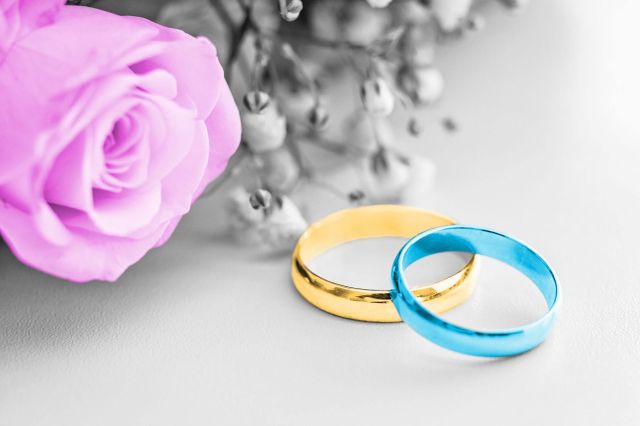
Keeping the Couple Apart Until the Ceremony
While not seeing your spouse-to-be until the ceremony starts is now a romanticized tradition, it once was considered a way to ensure marrying off a daughter happened as planned. Marrying for love is a relatively new concept; prior to the 18th century, marriage was primarily a means of improving a family’s social standing. Brides and grooms were often paired off without giving much of their own input, thanks to their families’ arrangements. Consequently, arranged marriages had a high risk for cold feet — which is why keeping the intendeds apart until they said their vows reduced the chances of one party backing out before they made it to the altar.

“Something Old, Something New”
Most modern brides who follow the “something old” tradition will borrow a family member’s wedding dress or jewelry, but brides of past centuries had no problem wearing someone else’s underwear as a good luck charm. The English rhyme, which reads “something old, something new, something borrowed, something blue, and a silver sixpence in her shoe,” originated some time during the mid-19th century and first appeared in print in 1871. These objects were thought to bring a bride luck for not only her wedding day, but also her chances of becoming pregnant. While “something old” could be almost anything, “something borrowed” was often a pair of bloomers on loan from a woman who had already become a mother.

Wearing a White Wedding Dress
Walk through any bridal shop and it’s obvious that white wedding dresses are the norm, but it wasn’t always so. Historically, brides often repurposed their best dress as their wedding gown, and most were not white — specifically because white was exceptionally difficult to keep clean prior to the advent of modern washing machines and stain removers. Queen Victoria, who wore a lacy white gown at her 1840 wedding in place of the then-popular red, is often credited for popularizing bridal white (though Mary, Queen of Scots wore white during her 1558 Notre Dame wedding, and many lesser-known royals did before Victoria’s reign, too). Within a decade of Victoria’s wedding, dressmakers and etiquette books had run with the idea that white was virginal and pure, with the popular Godey’s Lady’s Book writing that a white dress was “an emblem of the innocence and purity of girlhood, and the unsullied heart which she now yields to the keeping of the chosen one.”
More Interesting Reads

The Purpose of Bridesmaids and Groomsmen
Asking your nearest and dearest to be in your bridal party is one way of honoring friends and family members, though the task once came with a lot more work than just throwing a couple of showers and a bachelor/bachelorette party. For ancient Romans, having a bridal party was a legal means to an end — Roman law required 10 male witnesses to vouch for the couple, while a bride’s female companions would prepare and escort her to the ceremony. In many cultures, bridesmaids acted as incognito bodyguards for a bride; dressing similarly prevented kidnappers and thieves from making off with a bride’s dowry or the bride herself. As for groomsmen? Beyond helping the groom get ready, some of their historical roles included safeguarding the bride, preventing others from intervening in the wedding, or, in the darkest scenarios, kidnapping an unwilling or unwitting woman and forcibly bringing her to the groom.

Objections to a Marriage
While many couples now skip the infamous “speak now or forever hold your peace” line, it was once a standard question to prevent bigamy. During the Middle Ages, Christian churches required upcoming weddings to be announced three Sundays in a row, allowing time for the news to spread. If the bride or groom were already married to someone else, word could get back to the priest — who would ask one last time during the ceremony — to determine if the marriage could proceed.

Handfasting
Handfasting is often a unifying event at a wedding, though it didn’t start out that way. The practice dates to 7000 B.C.E. as part of a Celtic pre-wedding custom. Prospective couples would enter into a handfast ceremony with a priest, who would bind their hands together with a cord or ribbon. Brides and grooms who chose to handfast were considered engaged and had a year to determine if they were a good pair. If they were, couples would plan a wedding; if not, they were free to separate.

Exchanging Wedding Bands
The act of both parties exchanging a wedding ring is fairly modern; historically, men didn’t wear wedding rings. While women have worn engagement and wedding rings for centuries, they were often gifted as a gesture of betrothal (or in the Romans’ case, as a sign that a woman had entered into a marriage contract). During the 1920s, jewelers made an attempt to popularize the men’s engagement ring, which would be picked out and gifted by women, but the cultural norms about masculinity and marriage led to the ad campaign’s demise. It wasn’t until the 1940s that men’s wedding rings became socially acceptable — rings became seen as a romantic link between married couples who were separated during World War II, and post-Depression, couples could more often afford the cost of two rings.

Jumping the Broom
Jumping the broom is now a happier wedding ceremony element, but the tradition in Black communities has a somber history. During American slavery, Black enslaved people were sometimes permitted to exchange vows and wed in small ceremonies, but their marriages were not legally recognized because the law considered them to be property, not people. Jumping the broom — literally jumping over a simple broom that was sometimes placed along the threshold of a couple’s cabin — was an act that enslaved people sometimes performed to signify their union, especially in cases where a slaveowner did not recognize or approve of the marriage. However, historical accounts suggest that not all couples were eager to be wed that way for fear their marriages would be perceived as less meaningful than couples who had formal ceremonies. Now, many Black couples pay homage to their ancestors by choosing to jump the broom into a new life together.

Tossing Celebratory Rice
Showering newlywed couples with grains has its roots in many cultures, with the kinds used differing by region. Ancient Romans thought wheat was the best signifier of fertility, with rice taking up its role throughout Europe in the Middle Ages. Lentils, oats, peas, and other grains are also popular alternatives throughout the world. As for the theory that wedding rice is dangerous because it can explode a bird’s stomach at altitude? That’s an urban legend that became popular in the mid-1980s. Even if birds do consume a hefty amount of dried rice, the grains are broken up in their gizzards, making it impossible for their stomachs to expand unnaturally.

Saving Part of the Wedding Cake
The jury’s out on whether or not years-old frozen wedding cake is any good, but the tradition has held on regardless. That’s because saving the top tier of a wedding cake wasn’t necessarily about celebrating a first anniversary, but rather the birth of a first child. The earliest known wedding cakes baked by ancient Romans were made of wheat or barley, while cakes in Medieval England consisted of stacked spiced buns. It wasn’t until the early 1900s that multi-tiered wedding cakes became popular, and wedding etiquette of the time suggested happy couples who were successful at quickly starting a family could save money by using their remaining wedding cake as a christening cake; this became even more prevalent once home refrigerators and freezers became more common in the 1930s and ’40s. Queen Elizabeth II (then Princess Elizabeth) followed that advice and served a tier of her wedding cake at Prince Charles’s christening in 1948.












